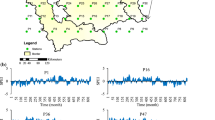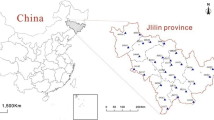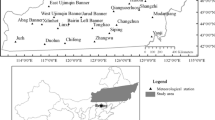Abstract
Assessment of spatiotemporal variations of drought is an efficient method for implementing drought mitigation strategies and reducing its negative impacts. This study aimed to assess the spatiotemporal pattern of short- to long-term droughts for an area with different climates. Therefore, 31 stations located in Iran were selected and the Standardized Precipitation Index (SPI) series with timescales of 3, 6, and 12 months were computed during the 1951-2016 period. A hybrid methodology including Maximal Overlap Discrete Wavelet Transform (MODWT) and K-means methods was used for obtaining the SPIs time-frequency properties and multiscale zoning of the area. The energy amounts of the decomposed subseries via the MODWT were applied as inputs for K-means. Also, the statistics in drought features (i.e. drought duration, severity, and peak) were assessed and the results showed that shorter term droughts (i.e. SPI-3 and -6) were more frequent and severe in the northern parts where the lowest values were obtained for drought duration. It was observed that the regions with more droughts frequency had the highest energy values. For shorter term droughts a direct relationship was obtained between the energy values and the mean SPIs, drought severity, and drought peak, whereas an inverse relationship was obtained for longer term drought. It was found that increasing the degree of SPI led to more similarity between the stations of each cluster. Also, the homogeneity of stations for the SPI-12 was slightly higher than the SPI-3 and -6.







Similar content being viewed by others
Availability of Data and Material
Monthly precipitation data of 31 sites of Iran are obtained from Iranian Meteorological Organization.
Change history
10 January 2022
A Correction to this paper has been published: https://doi.org/10.1007/s11269-021-03047-3
References
Agarwal A, Maheswaran R, Sehgal V, Khos R, Sivakumar B, Bernhofer C (2016) Hydrologic regionalization using wavelet-based multiscale entropy method. J Hydrol 538:22–32
Barton Y, Giannakaki P, Von Waldow H, Chevalier C, Pfahl S, Martius O (2016) Clustering of regional-scale extreme precipitation events in southern Switzerland. Mon Weather Rev 144(1):347–69
Chanda K, Maity R, Sharma A, Mehrotra R (2014) Spatiotemporal variation of long-term drought propensity through reliability-resilience-vulnerability based D rought M anagement I ndex. Water Resour Res 50(10):7662–76
Cornish CR, Bretherton CS, Percival DB (2006) Maximal overlap wavelet statistical analysis with application to atmospheric turbulence. Bound Layer Meteorol 119(2):339–74
Dadson SJ, Lopez HP, Peng J, Vora S (2019) Hydroclimatic extremes and climate change. Water Science, Policy, and Management: A Global Challenge, Wiley 11–28
Dghais AAA, Ismail MT (2013) A comparative study between discrete wavelet transform and maximal overlap discrete wavelet transform for testing stationarity. Int J Math Comput Sei Eng 12:1677–1681
Dinpashoh Y (2006) Study of reference crop evapotranspiration in IR of Iran. Agric Water Manag 84(1–2):123–129
Hsu KC, Li ST (2010) Clustering spatial–temporal precipitation data using wavelet transform and self-organizing map neural network. Adv Water Resour 33(2):190–200
Jain AK, Murty MN, Flynn PJ (1999) Data clustering: a review. ACM Comput Surv 31(3):264–323
Kwak J, Kim S, Jung J, Singh VP, Lee DR, Kim HS (2016) Assessment of meteorological drought in Korea under climate change. Adv Meteorol. https://doi.org/10.1155/2016/1879024
Li X, He B, Quan X, Liao Z, Bai X (2015) Use of the standardized precipitation evapotranspiration index (SPEI) to characterize the drying trend in southwest China from 1982–2012. Remote Sens 7(8):10917–10937
Likas A, Vlassis N, Verbeek JJ (2003) The global k-means clustering algorithm. Pattern Recognit 36(2):451–461
Madadgar S, Moradkhani H (2013) A Bayesian framework for probabilistic seasonal drought forecasting. Hydrometeorol 14(6):1685–1705
Mann ME, Gleick PH (2015) Climate change and California drought in the 21st century. Proc Natl Acad Sci U S A 112:3858–3859
Marvel K, Cook BI, Bonfils CJ, Durack PJ, Smerdon JE, Williams AP (2019) Twentieth-century hydroclimate changes consistent with human influence. Nature 569:59–65
McKee TB, Doesken NJ, Kleist J (1993) The relationship of drought frequency and duration to time scales. In Proceedings of the 8th Conference on Applied Climatology 179–184
Mirabbasi R, Anagnostou EN, Fakheri-Fard A, Dinpashoh Y, Eslamian S (2013) Analysis of meteorological drought in northwest Iran using the Joint Deficit Index. J Hydrol 7(492):35–48
Montaseri M, Ghavidel SZZ, Sanikhani H (2018) Water quality variations in different climates of Iran: toward modeling total dissolved solid using soft computing techniques. Stoch Environ Res Risk Assess 32(8):2253–2273
Mukherjee S, Mishra A, Trenberth KE (2018) Climate change and drought: a perspective on drought indices. Curr Clim Chang Rep 4:145–163
Nanzad L, Zhang J, Tuvdendorj B, Nabil M, Zhang S, Bai Y (2019) NDVI anomaly for drought monitoring and its correlation with climate factors over Mongolia from 2000 to 2016. Arid Environ 164:69–77
Percival DB, Walden AT (2000) Wavelet Methods for Time Series Analysis, Cambridge Series in Statistical and Probabilistic Mathematics, 1st edn. Cambridge University Press, Cambridge, UK
Pham DT, Dimov SS, Nguyen CD (2005) Selection of K in K-means clustering. Proc Inst Mech Eng C J Mech Eng Sci 219(1):103–119
Roushangar K, Alizadeh F (2018) Entropy-based analysis and regionalization of annual precipitation variation in Iran during 1960–2010 using ensemble empirical mode decomposition. J Hydroinform 20(2):468–485
Roushangar K, Nourani V, Alizadeh F (2019) Corrigendum to a multiscale time-space approach to analyze and categorize the precipitation fluctuation based on the wavelet transform and information theory concept. Hydrol Res 49(3):724–743
Sakizadeh M, Mohamed MM, Klammler H (2019) Trend analysis and spatial prediction of groundwater levels using time series forecasting and a novel spatio-temporal method. Water Resour Manag 33(4):1425–37
Sujjaviriyasup T (2017) A new class of MODWT-SVM-DE hybrid model emphasizing on simplification structure in data pre-processing: A case study of annual electricity consumptions. Appl Soft Comput 54:150–163
Surendran U, Anagha B, Raja P, Kumar V, Rajan K, Jayakumar M (2019) Analysis of drought from humid, semi-arid and arid regions of India using DrinC model with different drought indices. Water Resour Manag 33(4):1521–1540
Tigkas D, Vangelis H, Tsakiris G (2019) Drought characterisation based on an agriculture-oriented standardised precipitation index. Theor Appl Climatol 135(3):1435–1447
Tigkas D, Vangelis H, Tsakiris G (2020) Implementing crop evapotranspiration in RDI for farm-level drought evaluation and adaptation under climate change conditions. Water Resour Manag 34(14):4329–4343
Van Loon AF (2015) Hydrological drought explained, Wiley Interdisciplinary Reviews. Water 2:359–392
Vicente-Serrano SM (2007) Evaluating the impact of drought using remote sensing in a Mediterranean, semi-arid region. Nat Hazards 40(1):173–208
Yang L, Deng M (2010) Based on k-means and fuzzy k-means algorithm classification of Precipitation. In 2010 International Symposium on Computational Intelligence and Design 1:218–221. IEEE
Zhou X, Wang P, Tansey K, Zhang S, Li H, Wang L (2020) Developing a fused vegetation temperature condition index for drought monitoring at field scales using Sentinel-2 and MODIS imagery. Comput Electron Agric 168:10727–10741
Funding
The authors did not receive support from any organization for the submitted work.
Author information
Authors and Affiliations
Contributions
Kiyoumars Roushangar: Conceptualization, Supervision, Methodology, Review & Editing. Roghayeh Ghasempour: Project administration, Investigation, Data Curation, Methodology, Writing. Vahid Nourani: Conceptualization, Methodology, Formal analysis, Review & Editing.
Corresponding author
Ethics declarations
Ethics Approval
Not applicable.
Consent to Participate
Not applicable.
Consent for Publication
Not applicable.
Conflicts of Interest / Competing Interests
The authors declare no conflicts of interest / competing interests.
Additional information
Publisher's Note
Springer Nature remains neutral with regard to jurisdictional claims in published maps and institutional affiliations.
The original online version of this article was revised: In this article the affiliation “Near East University, Faculty of Civil and Environmental Engineering, Nicosia, via Mersin 10, Turkey” is added to Author Vahid Nourani.
Rights and permissions
About this article
Cite this article
Roushangar, K., Ghasempour, R. & Nourani, V. Spatiotemporal Analysis of Droughts Over Different Climate Regions Using Hybrid Clustering Method. Water Resour Manage 36, 473–488 (2022). https://doi.org/10.1007/s11269-021-02974-5
Received:
Accepted:
Published:
Issue Date:
DOI: https://doi.org/10.1007/s11269-021-02974-5




